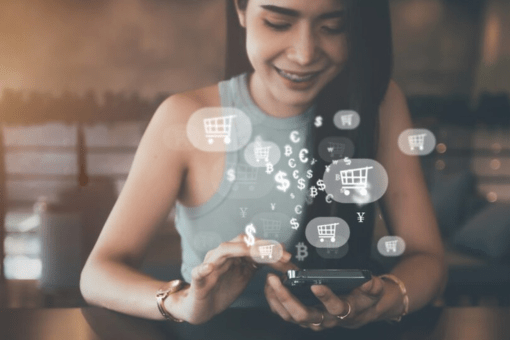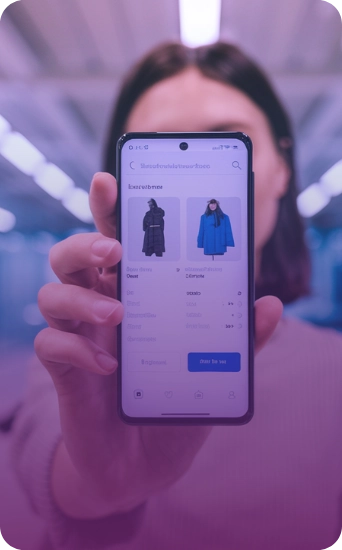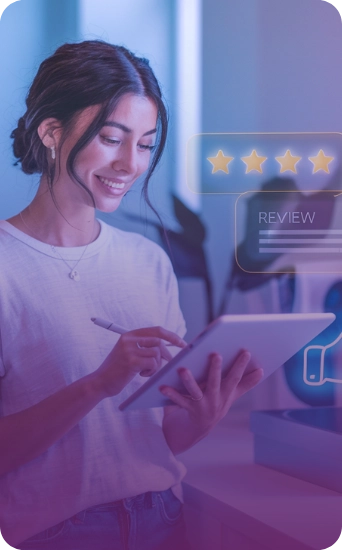We are very proud to have been part of VTEX Day 2023!

Our participation was marked by incredible moments, valuable connections and a generous dose of inspiration. Plus, the big launch of our new identity. The event was a true celebration of innovation and success in digital commerce. We would like to thank VTEX for giving us this unique experience and our customers, partners and prospects for visiting our stand. We move forward, driven and ready to reach new heights in the digital commerce universe. Together, we are shaping the future of e-commerce without limits. Follow our networks or get in touch:
The benefits of intelligent search in e-commerce

Today's consumer often comes to the store better informed and closer to making a purchasing decision than ever before. Many window displays are now done on a single screen and use intelligent search as the main tool for converting sales. So how can you make your e-commerce site more efficient in terms of sales? This is a constant question for many entrepreneurs, and one of the main answers has to do with intelligent search. Are you familiar with this feature? In basic terms, a search is an approach to finding content on the Internet or within a system/platform with the aim of providing the end user with the most relevant results possible via a search engine. However, search engines and their results have become a strategic tool for businesses: today, for all companies, being part of Google's results means the possibility of having more customers and carrying out transactions. And e-commerce is no different! Read on to discover the differences between search engines and how an intelligent search can boost your online sales. Search engines are smarter The reality of search results today shows us how far we've come in the use of search engines. The result of a "Google" doesn't bring up something basic or conceptual, it already directs us to something really useful and applied to a specific objective. Search personalization techniques have been a step towards what we call intelligent search - search engines already index web content according to the user's interests. We gain efficiency in results and increase productivity. On the other hand, the advancement of the technology employed by search engines has also led intelligent search to results in favor of advertisers. Intelligent search applied to e-commerce It is essential for your online store to show relevant suggestions in a search to give your customer an idea of the depth of your product range. This makes sense when you are selling thousands of products of a similar type or from a single range. Smart search stands out as a feature applied to e-commerce, since a homepage cannot display all the products sold. Therefore, the "Search" option is the next thing you should focus on in order to increase your sales. The faster and more accurate the result, the better the experience provided by the search engine and your store. On the contrary, ineffective and slow results can lead to user frustration and shorten the life of your e-commerce business. In practice, we can think, for example, of an online bookstore that offers to search for books by title, author or genre. Even if someone can't remember the entire title or author's name, intelligent search can help your customer complete their search quickly. Features of intelligent search in e-commerce Promoting your products online is a challenge, so it's crucial that you show your customers relevant search results. An example of this efficiency is the return of the best-selling products based on the search carried out. To do this, your intelligent search tool needs to have a few key features. Spell check and autocomplete Help your visitors with the autocomplete feature and never lose a sale because of a typo thanks to the spell check function. Your intelligent search needs to learn from all the wrong entries and automatically suggest relevant products in future searches. The power of Artificial Intelligence Your online store's intelligent search feature needs to learn from searches already carried out, and integration with Artificial Intelligence helps you reach your sales target every day. It offers results comprising long and complex queries written in any case or form. Products can be written in different ways, including singular and plural. Relevant search filters Visitors browse results quickly and easily with dynamic filters. Intelligent algorithms applied to smart search generate relevant filters, simplifying search results to make navigation easier. This includes searching for relevant products, product categories and other characteristics such as weight, price and other options. Speed of results Finally, an important feature that can't be missing from your smart search is speed of results - after all, there's no point in effective results if they aren't presented quickly. Smart search in the age of mobile devices If you have understood the importance of smart search in your online store, understanding how strategic this feature is in the age of hyperconnectivity with the use of mobile devices will be easy. The Digital Transformation has led us to new habits of behavior and consumption, and smartphones have become an important decision-making tool. As well as adapting your online store to the size of mobile screens, you need to provide agile and efficient search resources to guarantee conversion into sales. Score one for intelligent search! And don't forget the voice search feature We haven't yet adopted voice search in our routine, but this will happen soon. This is shown by the investments made by Google, Amazon, Microsoft and Apple through their virtual assistants. Follow our networks or get in touch:
Storage with ANVISA

Although storing products may seem like a simple and easy action, it's not always the case, since there are materials that need to be stored in specific ways in order to guarantee that they will be well preserved and safe. Thus, when it comes to the industrial sector, depending on which sector it is, there is a need to carry out storage with ANVISA (National Health Surveillance Agency), which will ensure that there is a greater guarantee of safety in the procedure. CHARACTERISTICS OF STORAGE WITH ANVISA Storage with ANVISA can be carried out in a wide variety of sectors, such as the pharmaceutical, textile, automotive and food industries, with the aim of ensuring that all products in these sectors have their preservation characteristics guaranteed, such as the ideal temperature and the necessary hygiene. In order to ensure that these properties are in the best possible shape, ANVISA storage has the ability to control each of the necessary details of the given locations, in order to check points such as the current temperature. It is also worth noting that ANVISA storage is important even when separating the products to be stored, checking points such as the batch number and expiry date. In addition, when storing with ANVISA there is also often the responsibility to label the products and print their labels and leaflets when necessary, always in the right way. Another point to be aware of is the fact that although ANVISA warehousing is involved, in many cases some other type of certificate generation is also required. With a large infrastructure, Social Full Commerce, among its many specialized services, also manages logistics, guaranteeing the best quality in its services, with speed and punctuality. If you'd like to know how Social's e-commerce processes work for your online store, book a call: comercial@socialsa.com or by phone on 11 41186493 Follow our networks or get in touch:
Reverse logistics: challenges and opportunities in e-commerce

There are two types of reverse logistics: post-sale and post-consumer. In the case of e-commerce, reverse logistics is nothing more than returning a product to its point of origin, i.e. exchanging or returning it. In a physical store, the process is quite easy, as the customer returns with the product and the invoice and can exchange it for another one on the spot, depending on stock availability. However, in online stores this operation is much more complex than you might think. At least three factors are fundamental in the logistics flow so that the customer exchanges or returns the product in the shortest possible time: the logistics operator, the supplier or distributor and the e-commerce store. Regulations, guarantees and consumer rights The Consumer Protection Code guarantees that the consumer has up to seven days to withdraw from the purchase and return a purchase made online. However, every store must have an operational structure to meet this demand. Delivery failure factors Before bearing the costs of an exchange or return, there is one item for companies to consider: the so-called delivery failure factors. Whenever a product leaves the Distribution Center via the carrier, until it reaches the consumer, some barriers are encountered along the way: non-existent address, product damage due to handling during transport, customer not found and restrictions on streets and avenues. Carriers usually make two to three attempts to deliver a product. After that, the product is returned and enters the reverse logistics management system of the distribution center of origin. Challenges to overcome Getting a product exchanged in the shortest possible time is not always an easy task. This is because the store depends on the customer returning the product, which can be done via the post office or by carrier collection, to assess the condition of the product and start the redelivery process. There is no estimate for this new delivery to be made in a standard time, as many variables are involved in the process. To mitigate the inconvenience of exchanges and returns, logistics experts recommend that small adjustments are necessary, especially in the clothing segment. According to a survey by Nuvem Envios Brasil, the rate of returns and exchanges in the country was around 10% in 2021. In some sectors, such as clothing, this percentage could reach 30%. Some solutions to reduce the rate of returns are to detail the characteristics of the products as much as possible on their respective digital pages, insert a table with clothing measurements in universal standards, and publish reviews and considerations from other buyers, as they are often useful references for other customers. Other challenges are also found in the food, medicine and cosmetics categories. In these categories, the high rates of returns are due to the irregular standardization of batches, i.e. some inform batches by letters, others only by numbers. This makes it difficult to monitor the expiration date of products and the consequence is that more attentive customers return them. Technology at the service of reverse logistics The entire reverse logistics process is made easier with the use of technology. Whether post-sale or post-consumption, the operational process gains in agility and efficiency, as well as reinforcing brand positioning and providing a positive customer experience. The challenge here is to make the consumer trust the delivery process and receive their goods in perfect condition. And for the exchange process, when it occurs, to be simple for the consumer, it is important to work with transparency and agility. To do this, some requirements are fundamental: hiring an efficient carrier is the main action, as well as investing in intelligent software management processes, platforms that classify what is common delivery and what needs more attention, such as route planning for returns, monitoring and traceability. The future: new forms of delivery and distribution are possible Consumers often choose to buy online because of the facilities such as not having to face queues and traffic, as well as any unforeseen events, especially on special dates. When we choose to buy a product from an online store, the last thing we expect is to experience any kind of inconvenience. But what if the product that arrives isn't the one you chose? If you have to return the product, depending on how the company handles reverse logistics after the sale, it can be a headache for the buyer. To avoid dissatisfaction and frustration, logistics is fundamental to reversing any dissatisfaction and regaining the consumer's trust, increasing the chances of repurchase in the future. To speed up both the delivery process and reverse or normal logistics, experts agree that the trend in the near future is for companies to invest in the creation of mini-hubs (smaller storage centers). Able to shorten delivery distances, mini-hubs reduce costs with carriers who often have to travel from one state to another to make deliveries. This trend reduces freight and the handling of goods, which reduces the chance of damage, another factor in returns. The creation of mini-hubs speeds up deliveries in places where sales figures are much higher, such as São Paulo, Rio de Janeiro, Belo Horizonte, Porto Alegre and Brasília. Another trend in the market is the use of physical stores to pick up goods. The term is known as pick up at Parcel Shops, which can be a pharmacy, a gas station or a bakery, for example. This form of delivery is quite common in Europe and the USA and is coming to Brazil. And in the not-too-distant future, we'll see drones delivering packages. It's not news that many companies have already started testing this, such as Amazon and iFood. Although the technology is making great strides, the companies are awaiting authorization from the country's legislation to put their plans into practice. Still talking
Cross Border: how to internationalize your brand and profit more from sales

The new trend in Brazilian e-commerce is Cross Border, which consists of buying or selling products online directly from other countries. Before the pandemic, some consumers were wary of online purchases, as products took a long time to arrive and there was a fear of paying taxes. However, the professionalization of the logistics and digital marketing markets, as well as the digitalization of consumers over the last two years, have boosted the growth of online sales. According to data from Webshoppers 44 by Ebit|Nielsen, the volume of sales of products bought by Brazilians across borders is estimated at R$ 9.6 billion reais in the first half of 2021, an increase of 15% in the number of orders compared to the previous half. In 2020, the total volume of foreign sales here passed R$ 22.7 billion. The figures show the confidence that consumers now have in buying products abroad. The reduction in delivery times and the quality of the products, as well as lower prices than those sold in Brazil, are the main incentives for shopping online from other countries. This disparity between the prices of products purchased in Brazil and abroad has had an impact on local sales. Brazil still suffers from the costs of selling products, due to the country's high taxes. Many entrepreneurs have realized that selling abroad can be more advantageous and with higher profit margins. Countries that benefit most from Cross Border According to data from Forrester's "Seizing the Cross-Border Opportunity", 82% of consumers worldwide have already bought from websites in other countries. And in this scenario of accelerating international purchases, Latin America is one of the leaders, with 83% of the population reporting having already made international purchases. On the other hand, China is in the lead among the countries that sell the most. The markets that buy the most online from other countries are North American, followed by European and Chinese. And if it's hard to compete with the Chinese here in Brazil, it may be easier in the US. After the US government surcharged Chinese products at 25%, Brazilian companies were better able to compete. The fact that the real is devalued against the dollar increases price competitiveness and gains strength in the American market. It may be possible to sell a product in the US for almost twice the price. Experts say that entrepreneurs fail to internationalize their products. This is often due to a lack of knowledge of regulatory laws, a belief in the complexity of the processes and the fact that high taxes and the rising dollar can make it impossible to internationalize their products. Here are 8 key points to take into consideration when starting your Cross Border business: 1. Market analysis Analyzing the target market and understanding whether there is in fact a demand for your products in the country is the first step to be analyzed before venturing into international territories. 2. export costs To export products, it is advisable to check the cost of international freight, so that it is not more expensive than the product itself, and to find out what rules apply in the destination country. 3. multilingual resources In addition to language, it is necessary to ensure the spelling of words and phrases, taking into account regional and cultural differences between countries. Labels or user manuals should be translated into the local language to facilitate the sale of products. 4. reverse logistics If it's already costly to carry out reverse logistics within Brazil, imagine this operation from other countries. Choosing a product that doesn't generate so much reverse logistics can be fundamental in this business, as you will invariably come to the conclusion that it is better to lose a product than to import it back in an international operation. 5. platforms Choosing the right platform to set up your e-commerce is essential if you want to internationalize your brand. Often, local platforms may not serve the international market in terms of technology, SEO and integrations. 6. automatic currency conversion Products must be priced in different currencies in order to calculate the price of the input in its country of origin. For this reason, payment must be made on platforms that accept international transactions with the sale of different currencies and the invoice must contain the value with the cost of the currency exchange rate on the day of purchase. 7 Payment methods Not all payment methods accept international currencies. So be careful when choosing your payment provider so that you don't have any surprises when it comes to selling your products in other currencies. 8 Identifying the ideal marketplaces to work with Identifying which marketplaces are related to your product and hosting your online store can be a strategic move to boost your sales in the global market. How to start Cross Border Starting Cross Border requires analysis and strategic planning. As well as identifying the best product categories and the best country for your sales, you need to have a brand internationalization plan. One of the companies that provides this type of service is Social Digital Commerce, with over 20 years' experience in the sector. In other words, the company acts as an integrator, taking care of the entire Cross Border operation. Full Comex guarantees end-to-end coverage, from the creation of the project to the adaptation of the brand and product communication process. Sales start directly from the company's warehouse in Miami. In this way, it is possible to obtain a 35% reduction in freight costs, as well as gaining time and agility in product delivery. Social Digital Commerce has professionals with business experience who can offer a wide range of tax services, as well as consultancy in assessing the risks and benefits involved in this trade. Which categories are worth selling on the international market? The product categories that are on the rise for cross border sales are: toys, cosmetics, jewelry, watches, art and beauty. Clothing and footwear
Who is consumer 5.0?

The 5.0 consumer is more connected to the internet and is more digitally savvy than anyone. The 5.0 consumer is looking for a good shopping experience and is therefore looking for like-minded stores, as well as good quality products at a low price. Therefore, your e-commerce needs to be prepared and adapted to this type of consumer, because today the customer has more say in what they ask for and demand. That's why you need to be aware that competition has increased with the arrival of the 5.0 consumer, who has many channels for researching products and services. This means that they are not easily swayed. Most of these consumers are part of generation Y and Z, and were born into the digital environment, so they are very comfortable using technology, such as smartphones, for their purchases. If for past generations the internet was a source of research and knowledge, for the 5.0 consumer technology also functions as a means of acquiring goods and products. How to reach the 5.0 consumer? The 5.0 consumer expects much more than a commercial exchange with companies. They want a close relationship, so that this relationship generates a great customer experience. For this group, a good experience is much more important than buying a good product. In order to attract, win over and retain the 5.0 consumer, companies need to check that their marketing strategies are being conveyed through the right communication channels - mostly in the virtual environment. Using data to identify needs, what the audience is saying about the brand and make quick changes is essential to achieve the desired results. To do this, it's important to understand the language used by your customer, so that you can get closer to them and create a connection. You also need to be available on various communication channels so that the 5.0 consumer can solve their questions and problems quickly and easily. The great secret to this is to be connected to many people, but not to communicate with them en masse. You need to talk to them and engage with them individually. In this way, it is possible to generate a better experience for the 5.0 consumer and ensure that the company is executing a strategy focused on its customer's needs. Be available As we said, the 5.0 consumer doesn't just want to be served during business hours and on a single channel. You need to offer options and be available, from email, social networks, WhatsApp, Apple Business Chat and various other digital channels. Remember: it's important to be where your audience is. This doesn't just mean having a profile on all the networks and channels, but actually understanding the particularities of your consumer and sector in order to offer what they expect and reach them effectively. And more than just being present, you need to be able to offer service and support on all channels - after all, customers can contact your company at 9am or 3am, right? To do this, it's important to invest in technology and automation and use a chatbot to serve your customers. With this type of robot, your company is available 24 hours a day, 7 days a week and makes the first contact with the public, never leaving them without answers. To engage and retain this customer, you need to offer differentiated experiences at every point of the customer journey. You need to know your customer, define their points of contact and actions so that there are strategies designed for their moments. Invest in the experience Offering an experience is also about being omnichannel, i.e. being able to maintain the context and satisfaction of the consumer during all their interactions and journeys, whatever their points of contact. The 5.0 consumer wants to feel important and heard by the company, so collecting feedback is essential for the relationship. Ask for their opinion, demonstrate its importance and, of course, use what you've collected in practice. Listen to your client and ask for feedback It's not enough to use feedback to feed spreadsheets, you need to understand the company's errors and processes, collect points for improvement and act to optimize them. When you notice changes and updates in your procedures, the customer will value your business even more. Looking at the customer's profile and understanding where they are, who they are and what they expect is essential in order to devise strategies that have to do with their real moment and needs. Social Full Commerce offers modern resources to streamline and simplify any e-commerce operation. In addition to a full commerce knowledge base that makes all the difference in the commercial sphere. Want to increase your online sales? We deliver e-commerce projects according to your company's needs. Follow us on the web or get in touch:
Reverse Logistics: what is it and tips for your e-commerce?

The reverse logistics process has become a key component of any streamlined and successful supply chain. To help you get started, here's everything you need to know about it. Many people associate reverse logistics with simply covering returns, but it's much broader than that. More than just understanding "what is reverse logistics", it's important to know the history of reverse logistics, its benefits and why it's a practice on the rise, especially in the after-sales industries. Due to the sheer volume and cost of processing returns, reverse logistics today presents one of the biggest operational challenges in the virtual marketplace. And as more retailers offer free shipping, more consumers are taking the opportunity to return products because they know there will be no cost to them. All to be more satisfied with their purchase! Understand what reverse logistics is, and how its use can impact on the sales process and your relationship with your customers. What is reverse logistics? Reverse logistics is the return journey that a product may need to make in the internet shopping process. In other words, from the consumer to e-commerce. In other words, it's a type of supply chain management that moves goods from customers back to sellers or manufacturers. Once a customer has received a product, processes such as returns or recycling require reverse logistics. Reverse logistics starts at the end consumer, moving back through the supply chain to the distributor or from the distributor to the manufacturer. Reverse logistics can also include processes in which the end consumer is responsible for the final destination of the product, including recycling, refurbishment or resale. This can happen for a variety of reasons, the most frequent being in the case of the return or exchange of clothing, footwear and electronic goods. It is worth remembering that the Consumer Defense Code stipulates that the customer has up to seven days after receiving the order to request an exchange or return of the product purchased. But as well as staying within the legislation, offering a simple and well-defined reverse logistics process also plays an important role in the customer experience in e-commerce. After all, in e-commerce, the sale doesn't end when the item is delivered to the recipient's address. The online store's position in the event of problems is decisive in defining customer satisfaction. Reverse logistics vs. traditional logistics The traditional flow of products starts with suppliers and goes to a factory or distributor. From there, the goods go to retailers and customers. Reverse logistics management starts with the consumer and, in the opposite direction, returns the products to any point in the supply chain. How do you organize reverse logistics in your e-commerce business? Defining reverse logistics processes is part of the freight strategy adopted by e-commerce. As such, you should have a routine set up for these situations. In short, you need to organize, monitor and optimize all the steps involved in returning or replacing products on the way back to the online store. For example, what does the customer need to do to send the product back to you? And, most importantly, how can you make it easier for them? Let's list three basic points: Posting the parcel to the carrier is the customer's responsibility. But you can speed things up for them by sending them a shipping label ready to send. The cost of shipping is the shopkeeper's responsibility. It is therefore important that you find the most favorable conditions. Ideally, customers and shopkeepers should have access to parcel tracking to ensure transparency in the process. The importance of reverse logistics for your business Reverse logistics is important because it maintains an efficient flow of goods. The process reduces costs, creates value, reduces risks and completes the product's life cycle. It also produces financial benefits while having a positive impact on the environment and corporate culture. Refining processes for what happens to products after delivery helps retain customers and save money. Product data collected when interacting with customers after delivery is an advantage of well-executed reverse logistics. The data provides information about an organization's supply chain and an opportunity to improve products and/or the customer experience. If executed well, it also leads to better visibility of the supply chain, leading to benefits such as: Experts say that by 20% of everything purchased will be returned. Returns are an expected part of commerce today, so the lack of a comprehensive program will disappoint consumers, leading to poor reviews. Therefore, the key to success is to treat reverse logistics with the same level of strategy, management oversight and investment as outbound logistics. Social Digital Commerce has the best reverse tool studies for your e-commerce. This way your customer's order will be returned to the online store in the simplest way and with the best conditions. Want to increase your online sales? We deliver e-commerce projects according to your company's needs. Follow our networks:
User reviews are a decisive factor in online shopping, research reveals

One of the factors that weighs most heavily when it comes to making an online purchase are the reviews of users who have already bought the same product on e-commerce. Since consumers can't see the product or service with their own eyes, the opinion of others is more important, according to research published by Worldpay from FIS. "Reviews weigh heavily in any type of online purchase, because the person is not in front of the place they are buying from. They prioritize reviews more than the reputation of the institution itself," said Juan Pablo D'Antiochia, manager of Worldpay from FIS in Latin America. According to the survey, the credibility of the company is another decisive factor when making a purchase. Those who don't believe the seller won't create an account or provide credit card details. Anti-fraud payment services are also a concern for consumers. Authentication at the time of purchase At the time of purchase, most consumers are willing to authenticate the payment in two steps for security reasons. The global favorite is authentication by digital biometrics (56%), followed by facial recognition (19%) and voice recognition (10%). 15% say they would not use the feature. When it comes to confirming payment, the preferred method is e-mail, with 90% of the Brazilians interviewed preferring it. SMS, on the other hand, is the least popular in the country and is used as a confirmation option by only 14%. D'Antiochia attributes Brazilians' preference to the characteristics of each of the tools. "The amount of content you can put in an e-mail is much greater than in an SMS. If you have a problem in the future, for example, it's easier to send an email to prove the situation than a screenshot of an SMS," he told the publication. Worldpay from FIS carried out a study on digital payment experiences and the preferences of 33,000 consumers from 12 countries about online education. Article E-Commerce Brasil Social Digital Commerce offers modern resources to streamline and simplify any e-commerce operation. In addition to a full commerce knowledge base that makes all the difference in the commercial sphere. Want to increase your online sales? We deliver e-commerce projects according to your company's needs. Follow us on the web or get in touch:
Digital payments and excellence in the customer journey

From September onwards, many important dates are expected to heat up retail sales, starting with Customer Day (15/09), followed by Children's Day (12/10), Black Friday (25/11), Christmas and New Year. There is no doubt that e-commerce will continue to see sales growth as we have seen in recent semesters. According to the Brazilian E-Commerce Association (Abcomm), the sector could end 2022 with net revenue of up to R$ 165 billion. In fact, a pertinent topic at the moment is investing in the growing demand for multiple payment options. With customers becoming ever more demanding, an important trend for the next few years in the consumer's online shopping journey is to make the experience ever more optimized, fluid and unified, which includes payment methods. In this article we will look at digital payments, which are growing rapidly and are beginning to replace the use of paper bills and coins. A global survey by VISA Back to Business shows that 97% of Brazilian consumers will continue to use digital payments much more than they did in 2021. Around 581% of Brazilian small businesses said they already operate or intend to operate without cash from the coming months. 50% of consumers said in the survey that they intend to abandon the use of banknotes and coins. Will cash disappear? It's too early to say whether cash will simply disappear. But experts say that the trend is for it to be replaced by digital payments. We're not talking about just one form of payment, but other emerging formats that should impact e-commerce, such as the consolidation of Pix, e-wallets (digital wallets), contactless (payments via biometrics or facial recognition), m-commerce (via mobile devices), digital currencies and cryptocurrencies. How do you guarantee security and experience in the purchasing journey? For consumers to have an excellent shopping experience, companies will need to invest more and more in well-defined identity verification and fraud prevention strategies in order to keep customers confident in the consumer platform. A survey carried out in the first half of this year by Capterra, a software comparison platform, with 1,024 people from various regions of Brazil, found that 58% of respondents said they were afraid of being scammed and 48% said they didn't feel comfortable sharing their personal data. Companies are realizing that diversifying payment models, offering agility, transparency and security are key factors in building customer loyalty. Even if a sale is approved in seconds, there are a series of complex checks behind it, which guarantee the suitability and reliability of that purchase. This process involves artificial intelligence and data analysis of that business model (e-commerce and its customers) to assess whether the cardholder's credit card, for example, has been cloned or stolen. Anti-fraud carries out various checks to ensure that the purchase is safe. How can we reduce the high rate of cart abandonment? But in this shopping journey, there are several factors that still challenge digital entrepreneurs, including the high rate of cart abandonment, i.e. the final moment of a sale may not happen. In online shopping, this rate is higher than in physical stores and is linked to a series of factors that have to do with high shipping, complex and time-consuming forms, the value of the order not being enough for free shipping, distrust of the sales site, system instability, technical failures and, yes, limited means of payment. To avoid frustrating your customers when they complete their purchase, check out our six tips for converting an abandoned shopping cart into a completed purchase: What about your business, are you ready for the trends in digital payment methods? Social Digital Commerce has numerous solutions for implementing different payment methods in your online store, as well as cutting-edge technology, professionals specialized in logistics and the most modern operational management systems on the market. Get in touch and let's talk! Follow our networks or get in touch:
How to serve the Digital Consumer?

In the last five years we have witnessed a profound change in the relationship between company and consumer. The buying journey is now measured by the experience provided by a product or brand. The digital world has shortened the consumer journey and with so much access to information, the market has had to adapt to the new behaviors of the digital consumer, 5.0. The evolution of the consumer over the years In the 1990s, the consumer profile was more practical and direct. The relationship between salesperson and customer was limited to a physical space. This was the so-called 1.0 consumer. With the expansion of the market, consumers now had more purchasing options, making competition between brands more intense. At this point, consumer 2.0 began to compare products and services. In turn, companies had to evolve to show their difference. In a bigger leap, we have reached consumer 3.0, who now has more access to information via the internet, with more autonomy when it comes to making a purchase. Likewise, they don't just care about the quality of the product, but also about effective and fast service. In other words, consumer 3.0's main characteristic is brand loyalty. With the rapid transformations in consumer relations and the strong digital acceleration, consumer 4.0 was born. This new profile attracted attention because it valued brands that were able to personalize their service and offer a humanized service. Understanding the 5.0 consumer We are now in the 5.0 consumer phase. Understanding this new type of customer involves analyzing both the evolution of relationships and technological advances. With technological evolution, our ability to interact with an individual anywhere in the world has transformed the way people view social relationships. This process has seen verbal contact rapidly replaced by writing. Nowadays, phone calls are rarely used, as people type more than they speak. With countless digital resources at their disposal, the 5.0 consumer will take advantage of this communication to inform themselves, evaluate and investigate the provenance of brands. The main characteristics of the 5.0 consumer are that they are heavy users of new technologies and social networks, that they value instant service, that they value the experience before the product and that they are attuned to current trends. The profile of this type of consumer includes, for the most part, the so-called "zoomers", i.e. people who were born into the world with the internet popularized, also known as digital natives. There are some peculiar issues in this 5.0 consumer profile. One of them, if not the most important, is the fixation on pleasurable experiences. With this demand, companies tend to increasingly look for strategies that can deepen efforts towards Customer Experience and align expectations in service relationships, regardless of the purchasing channel. The challenge for brands is enormous. To stay in the race, they will have to invest more and more in developing skills and competencies that offer products and services with instant, personalized and agile service. Key trends in customer service 5.0 A recent survey by Accenture, entitled Global Life Reimagined, shows that half of people have reassessed, during the pandemic, what is essential for living. These consumers are leading companies to redefine their service strategies. It's no wonder that companies that want to remain in the ranking of the best service providers value being attentive to the needs of emerging customers. This new 5.0 consumer no longer wants to be treated as just a number, they want to be part of the same ecosystem as a company. And that's the crucial point. Check out 5 trends in digital customer service: Does your brand offer excellent customer service? Social Digital Commerce has countless solutions to boost your online store's customer service, as well as cutting-edge technology, professionals specialized in logistics and the most modern operational management systems on the market. Get in touch and let's talk! Follow our networks or get in touch:










